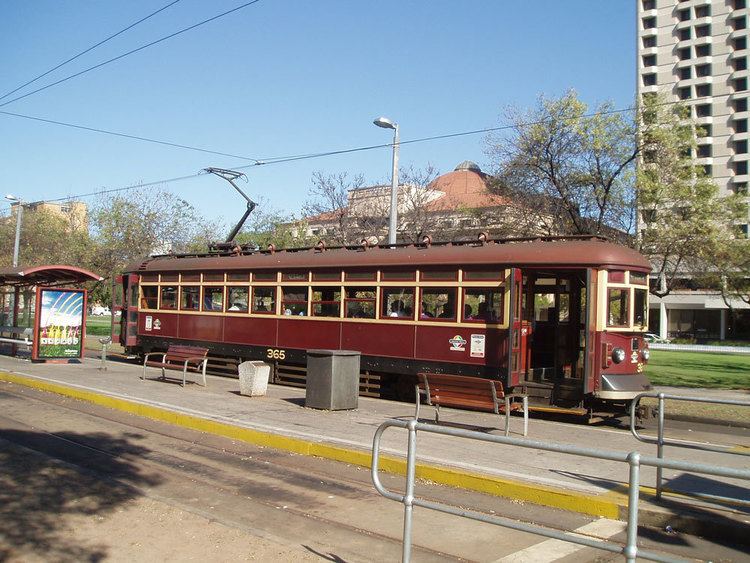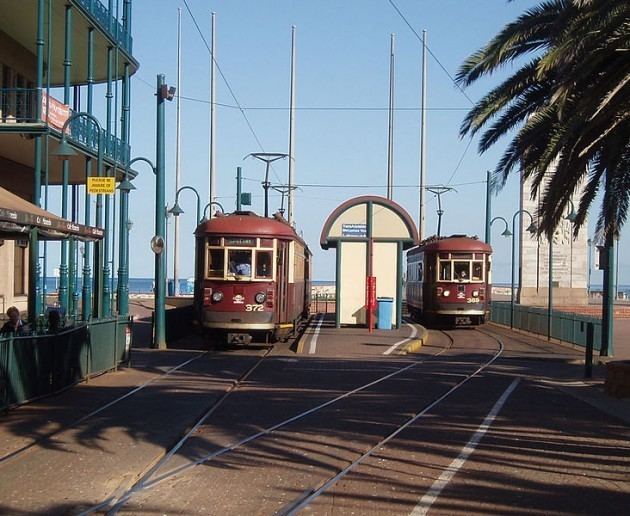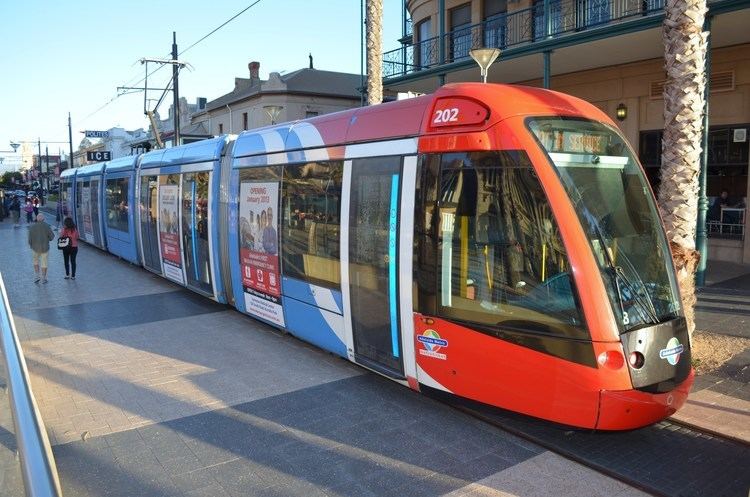Opened 1873 (1873) Electrified 1929 Locale Adelaide | Re-sleepered (concrete) 2005 Line length 15 km (9.3 mi) | |
 | ||
Services Every 5-10 mins (Peak)
Every 10 mins (Weekday)
Every 10 mins (Saturday)
Every 15 mins (Sunday)
Every 20 mins (Night) Rolling stock Flexity Classic
Citadis 302 Terminis Moseley Square, Glenelg, Adelaide Entertainment Centre, Hindmarsh | ||
Glenelg tram traffic priority
The Glenelg tram is a 15-kilometre (9.3 mi) light rail line in South Australia running from Hindmarsh, through the Adelaide city centre, to the beach-side suburb of Glenelg. It is Adelaide's only remaining tramway.
Contents
- Glenelg tram traffic priority
- The old glenelg tram
- Inception
- Municipal Tramways Trust
- Renaissance
- City centre extension
- South Road Overpass
- Adelaide Entertainment Centre extension
- Patronage
- Controversy
- Flexity Classic
- Citadis 302
- H class
- Planned East End and Festival Plaza extensions
- Proposed extensions
- References

The service is free between the Adelaide Entertainment Centre in Hindmarsh and South Terrace in the City, and along the entire length of Jetty Road, Glenelg. Apart from short street-running sections in Adelaide city centre and Glenelg, the line has its own reservation, with minimal interference with road traffic.

A 1.6 kilometre northern extension through the city centre opened on 14 October 2007 This extended the line from Victoria Square along King William Street and North Terrace to Morphett Street. A further 2.8 kilometre north western extension of the line along Port Road to the Adelaide Entertainment Centre opened on 22 March 2010. A 1 kilometre branch line along the eastern end of North Terrace was announced in 2016.

The old glenelg tram
Inception

The route was built in 1873 by a private company, the Adelaide, Glenelg & Suburban Railway Company Ltd. The original line had a very different character to today’s route.


Patronage during the first few years of operation rose from 468,000 in the first year (1873-4) to 727,000 in 1877-8.
In December 1899 the private company was acquired by the state government-controlled South Australian Railways (SAR), who continued to operate the line as a steam railway for the next 30 years or so. In 1914, the railway’s terminus was cut back from the edge of Victoria Square (in the centre of Adelaide) to South Terrace on the city’s southern fringe. Passengers had to transfer to electric trams to complete their journey into the city.
Municipal Tramways Trust
In 1929 ownership and operation transferred from the SAR to Adelaide’s Municipal Tramways Trust (MTT). Steam trains ceased on 2 April 1929 and the line was closed to be rebuilt to standard gauge, electrified at 600 V dc and converted to tramway operation. The Goodwood flyover was constructed at this time, separating the new tram tracks from the conventional railway.
Thirty H class trams were built for the line, with a design influenced by North American interurban cars of that era. The line re-opened on 14 December 1929, with the city terminus reverting to Victoria Square.
There were one or two quirks in the earlier years, the most famous being the “horse trams” operated in the 1930s. These were trams specially constructed to carry race horses from stables located along the line to the racecourse at Morphettville. This service was a carry-over from the days of the steam railway, which had also performed this function. Another unusual feature was operation of triple sets of H-class trams in peak hours, and express trams that ran non-stop over a significant portion of the route. In 2006, only one express service remained.
The line was the only route to survive the closure of Adelaide’s street tramway network during the 1950s, saved largely by its high proportion of reserved track, which enables fast journey for passengers and minimal interference with road traffic.
In the mid-1970s around 3,000 trips to the city were made "on an average day". The line's depot relocated 1986, moving from the corner of Angas Street and Victoria Square in central Adelaide to a new facility at Glengowrie, close to Glenelg.
Renaissance
In the 21st century, a series of investments were made to improve and extend the line. This began in May 2003 when the South Australian Government announced an upgrade of the Glenelg line infrastructure and the introduction of new trams.
Major work to upgrade the line took place between 5 June and 7 August 2005. Concrete sleepers were installed and much of the track renewed in an intensive nine-week project. Most of the 21 tram stops were reconstructed with higher platforms to allow level access to the new low-floor trams. The overhead electrical supply was upgraded and some minor modifications were made to the H-class cars and Glengowrie depot. Tram services were replaced with substitute bus services during this period. Tram services resumed on 8 August 2005. The terminus at Moseley Square, Glenelg was reconfigured in September 2005 as part of a general redevelopment of the square.
City centre extension
The South Australian Government announced a 1.2 kilometre extension from Victoria Square along King William St. to Adelaide railway station on 6 April 2005. An additional two Flexity Classic trams were ordered (for a total of 11) to cater for services on the city centre extension.
Construction work on the extension commenced in early 2007. A new Victoria Square stop opened on 6 August 2007. The stop moved from the centre of the square to the western side. Testing of the extension began in September 2007.
The extension opened on 14 October 2007. Initially, a shuttle service running between Victoria Square and City West tram stop was provided. Normal services continued to run between Victoria Square and Glenelg. A new timetable began on 15 October 2007 with through services from Glenelg to City West and a free shuttle service between South Terrace and City West.
South Road Overpass
An overpass crossing South Road was announced in the 2007 South Australian Budget. The project was built in conjunction with the Anzac Highway Underpass. Construction started in July 2009 and was due to be completed by the end of 2009. In December 2009, the overpass opened to allow trams to pass over it, however the South Road tram stop was not operational until 15 March 2010.
Adelaide Entertainment Centre extension
A $100 million extension to the Adelaide Entertainment Centre was announced in the 2008 South Australian Budget. Planning commenced soon after and the state cabinet approved the extension in November 2008.
Construction work began on 11 May 2009. Testing began in February 2010 and the extension opened on 15 March 2010.
Patronage
The following table lists patronage figures for the network (in millions of journeys) during the corresponding financial year. Australia's financial years start on 1 July and end on 30 June. Major events that affected the number of journeys made or how patronage is measured are included as notes.
Controversy
Due to the increased popularity of the service beyond the city after the extension, the trams service dramatically exceeded its capacity, with over 100,000 extra trips for the three months from November 2007, compared the same period the previous year. This resulted in intensive overcrowding on board the trams, and many passengers were unable to board trams during peak hours. The extension of the tramway along King William Street and North Terrace was blamed by critics for increased congestion within the centre of Adelaide, but no actual evidence of this occurring was identified.
There have been a small number of minor derailments along the tramway, including one on Melbourne Cup Day, 6 November 2007. On several occasions, some Flexity trams experienced breakdown problems.
Flexity Classic
A contract for delivery of nine new Flexity Classic trams was awarded to Bombardier on 21 September 2004. The first Flexity tram (101) arrived in Adelaide on 22 November 2005. Following a period of commissioning and staff training, the first two Flexity trams (101 and 102) entered service on 9 January 2006. A further two trams were added to the order, followed by another four as part of the Adelaide Entertainment Centre extension, entering service in 2011. Numbered 101-115, all were built by Bombardier Transportation in Germany.
Citadis 302
In May 2009 the State Government purchased six Citadis 302 five car trams for $36 million. Manufactured by Alstom in France, they had been ordered for the Metro Ligero de Madrid system in Madrid, Spain, but became surplus following the line they were ordered for being scaled back.
The trams were delivered in two separate batches of three to Australia being landed in Melbourne on 9 September 2009 and 10 November 2009 for modifications at Preston Workshops before being moved by road to Adelaide. Delivered as Metro Ligero de Madrid's 165-170, they were renumbered 201-206 by TransAdelaide.
H class
Until January 2006, 1929-vintage H class trams provided all services on the Glenelg line. These trams were built for the electrification of the Glenelg line and have many of the characteristics of American "interurban" cars of the same period. Thirty H class trams were built by a local manufacturer, A. Pengelley, with road numbers 351 - 380.
The H-class cars were progressively updated during the 1970s, again in the late 1980s and most recently (on five trams) in 2000. These included toughened safety glass in windows, replacing wooden panels with fibreglass, upgrading bogies, fluorescent lights inside the cars, and sealed-beam headlights and brake/hazard lamp clusters outside. In 1986 the trams were converted from trolley pole to pantograph operation. Despite the various refurbishments and upgrades, the overall character of the H-class trams has stayed very much as they were built. The interiors are still varnished wood and glass etched with MTT logos, and with no heating or air conditioning. Any remaining services are crew operated, with a driver and conductor on single cars, or a driver and two conductors on two-car sets.
The H-class were the longest rigid-body trams remaining in service in Australia, and the second-longest ever built. They travelled in pairs during peak times, and with the retirement of the W2 trams from Melbourne's network were the oldest passenger trams in service in Australia.
Five refurbished H-class trams are still in the fleet. They operated a restricted 'heritage service' timetable on Saturdays, Sundays and Public Holidays. The H class trams are currently not in use but are stored at the depot awaiting a decision on their future. They have been fitted with safety measures similar to those of the new trams, including vigilance control and electro-magnetic track brakes. The retained H-class trams are numbers 351, 367, 374 and 380. Three of the trams are currently stored near Tonsley.
Planned East End and Festival Plaza extensions
After a lobbying campaign from businesses and institutions located in the area, a $50 million project to construct a one-kilometre branch along the eastern section of North Terrace was announced in 2016 South Australian Budget. The extension will enable the creation of shuttle service between the old Royal Adelaide Hospital and the Adelaide Entertainment Centre. Services will operate every ten minutes. A tender to design and construct the project was called in December 2016. Works are scheduled to commence in the first quarter of 2017 and be completed by the end of the year. An expansion of the project was also announced in December 2016. This will see a 100-metre northern spur line constructed from North Terrace to Festival Plaza. The intention is to avoid modifying the North Terrace-King William Road intersection twice - once for the East End extension, then again if the proposed ProspectLINK extension goes ahead - by combining all the work into a single program. Three new trams will also be ordered. The changes resulted in an extra $20 million being added to the budget for the project. The construction timeline remains unchanged. The eastern branch will include three new stops: Museum (Gawler Place), Pulteney Street and East End. The northern branch will include a single stop, called Festival Plaza.
Proposed extensions
Several extensions to the network have been proposed under a program called AdeLINK. A report analysing the route options was released in 2016. Six routes would radiate from the Adelaide city centre and one would form a city centre loop. The routes are:
PortLINK is the most complex of the proposals, as it involves making decisions on the future of the Outer Harbor and Grange railway lines. The report proposes several different options for these lines. They could be electrified but remain as heavy rail, or they could be converted to light rail - with potential spurlines added to West Lakes and Semaphore. Light rail options for the Grange railway line include converting the entire line to light rail, diverting it to West Lakes and closing the section beyond Albert Park station, or replacing it with new on-street routes to Grange and West Lakes. The PortLINK routes are very similar to a group of light rail extensions to West Lakes, Port Adelaide and Semaphore that were announced in the 2008 South Australian Budget but then scrapped in the 2012 budget.
